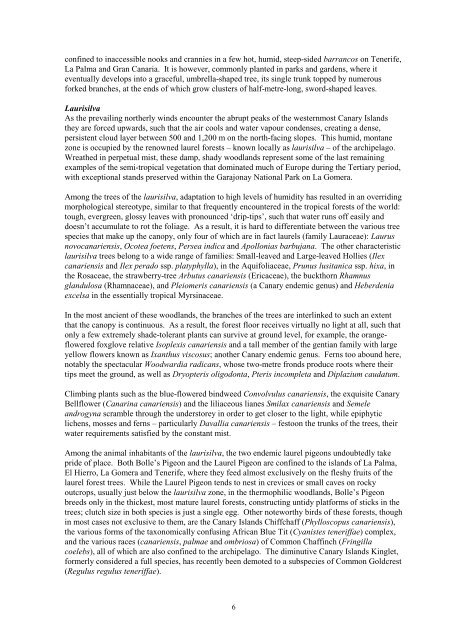Download - Botanical Society of the British Isles
Download - Botanical Society of the British Isles
Download - Botanical Society of the British Isles
- No tags were found...
You also want an ePaper? Increase the reach of your titles
YUMPU automatically turns print PDFs into web optimized ePapers that Google loves.
confined to inaccessible nooks and crannies in a few hot, humid, steep-sided barrancos on Tenerife,La Palma and Gran Canaria. It is however, commonly planted in parks and gardens, where iteventually develops into a graceful, umbrella-shaped tree, its single trunk topped by numerousforked branches, at <strong>the</strong> ends <strong>of</strong> which grow clusters <strong>of</strong> half-metre-long, sword-shaped leaves.LaurisilvaAs <strong>the</strong> prevailing nor<strong>the</strong>rly winds encounter <strong>the</strong> abrupt peaks <strong>of</strong> <strong>the</strong> westernmost Canary Islands<strong>the</strong>y are forced upwards, such that <strong>the</strong> air cools and water vapour condenses, creating a dense,persistent cloud layer between 500 and 1,200 m on <strong>the</strong> north-facing slopes. This humid, montanezone is occupied by <strong>the</strong> renowned laurel forests – known locally as laurisilva – <strong>of</strong> <strong>the</strong> archipelago.Wrea<strong>the</strong>d in perpetual mist, <strong>the</strong>se damp, shady woodlands represent some <strong>of</strong> <strong>the</strong> last remainingexamples <strong>of</strong> <strong>the</strong> semi-tropical vegetation that dominated much <strong>of</strong> Europe during <strong>the</strong> Tertiary period,with exceptional stands preserved within <strong>the</strong> Garajonay National Park on La Gomera.Among <strong>the</strong> trees <strong>of</strong> <strong>the</strong> laurisilva, adaptation to high levels <strong>of</strong> humidity has resulted in an overridingmorphological stereotype, similar to that frequently encountered in <strong>the</strong> tropical forests <strong>of</strong> <strong>the</strong> world:tough, evergreen, glossy leaves with pronounced ‘drip-tips’, such that water runs <strong>of</strong>f easily anddoesn’t accumulate to rot <strong>the</strong> foliage. As a result, it is hard to differentiate between <strong>the</strong> various treespecies that make up <strong>the</strong> canopy, only four <strong>of</strong> which are in fact laurels (family Lauraceae): Laurusnovocanariensis, Ocotea foetens, Persea indica and Apollonias barbujana. The o<strong>the</strong>r characteristiclaurisilva trees belong to a wide range <strong>of</strong> families: Small-leaved and Large-leaved Hollies (Ilexcanariensis and Ilex perado ssp. platyphylla), in <strong>the</strong> Aquifoliaceae, Prunus lusitanica ssp. hixa, in<strong>the</strong> Rosaceae, <strong>the</strong> strawberry-tree Arbutus canariensis (Ericaceae), <strong>the</strong> buckthorn Rhamnusglandulosa (Rhamnaceae), and Pleiomeris canariensis (a Canary endemic genus) and Heberdeniaexcelsa in <strong>the</strong> essentially tropical Myrsinaceae.In <strong>the</strong> most ancient <strong>of</strong> <strong>the</strong>se woodlands, <strong>the</strong> branches <strong>of</strong> <strong>the</strong> trees are interlinked to such an extentthat <strong>the</strong> canopy is continuous. As a result, <strong>the</strong> forest floor receives virtually no light at all, such thatonly a few extremely shade-tolerant plants can survive at ground level, for example, <strong>the</strong> orangefloweredfoxglove relative Isoplexis canariensis and a tall member <strong>of</strong> <strong>the</strong> gentian family with largeyellow flowers known as Ixanthus viscosus; ano<strong>the</strong>r Canary endemic genus. Ferns too abound here,notably <strong>the</strong> spectacular Woodwardia radicans, whose two-metre fronds produce roots where <strong>the</strong>irtips meet <strong>the</strong> ground, as well as Dryopteris oligodonta, Pteris incompleta and Diplazium caudatum.Climbing plants such as <strong>the</strong> blue-flowered bindweed Convolvulus canariensis, <strong>the</strong> exquisite CanaryBellflower (Canarina canariensis) and <strong>the</strong> liliaceous lianes Smilax canariensis and Semeleandrogyna scramble through <strong>the</strong> understorey in order to get closer to <strong>the</strong> light, while epiphyticlichens, mosses and ferns – particularly Davallia canariensis – festoon <strong>the</strong> trunks <strong>of</strong> <strong>the</strong> trees, <strong>the</strong>irwater requirements satisfied by <strong>the</strong> constant mist.Among <strong>the</strong> animal inhabitants <strong>of</strong> <strong>the</strong> laurisilva, <strong>the</strong> two endemic laurel pigeons undoubtedly takepride <strong>of</strong> place. Both Bolle’s Pigeon and <strong>the</strong> Laurel Pigeon are confined to <strong>the</strong> islands <strong>of</strong> La Palma,El Hierro, La Gomera and Tenerife, where <strong>the</strong>y feed almost exclusively on <strong>the</strong> fleshy fruits <strong>of</strong> <strong>the</strong>laurel forest trees. While <strong>the</strong> Laurel Pigeon tends to nest in crevices or small caves on rockyoutcrops, usually just below <strong>the</strong> laurisilva zone, in <strong>the</strong> <strong>the</strong>rmophilic woodlands, Bolle’s Pigeonbreeds only in <strong>the</strong> thickest, most mature laurel forests, constructing untidy platforms <strong>of</strong> sticks in <strong>the</strong>trees; clutch size in both species is just a single egg. O<strong>the</strong>r noteworthy birds <strong>of</strong> <strong>the</strong>se forests, thoughin most cases not exclusive to <strong>the</strong>m, are <strong>the</strong> Canary Islands Chiffchaff (Phylloscopus canariensis),<strong>the</strong> various forms <strong>of</strong> <strong>the</strong> taxonomically confusing African Blue Tit (Cyanistes teneriffae) complex,and <strong>the</strong> various races (canariensis, palmae and ombriosa) <strong>of</strong> Common Chaffinch (Fringillacoelebs), all <strong>of</strong> which are also confined to <strong>the</strong> archipelago. The diminutive Canary Islands Kinglet,formerly considered a full species, has recently been demoted to a subspecies <strong>of</strong> Common Goldcrest(Regulus regulus teneriffae).6
















